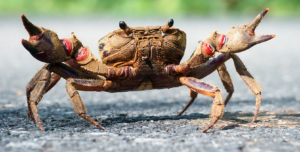 Crabs! (and obviously we’re talking about the crustaceans here) Crabs are ten-footed creatures or decapods, if you’re fancy like Dayton party bus services, just like lobsters. Unlike lobsters, however, they have only two claws, and their abdomens are smaller than a lobster’s, and are tucked up under their shell (which is an exoskeleton, like a lobster), giving them a much more roundish kind of shape. Crabs are very versatile little fellows, and can be found not only in every ocean on the planet, but also in fresh water and on land (so basically, if they wanted to take over, they pretty much could). Do take note, however, that if such an invasion of crabs were to occur, it would not include creatures like the hermit crab or the king crab, because, though they do have the word crab in their names, they are not true crabs.
Crabs! (and obviously we’re talking about the crustaceans here) Crabs are ten-footed creatures or decapods, if you’re fancy like Dayton party bus services, just like lobsters. Unlike lobsters, however, they have only two claws, and their abdomens are smaller than a lobster’s, and are tucked up under their shell (which is an exoskeleton, like a lobster), giving them a much more roundish kind of shape. Crabs are very versatile little fellows, and can be found not only in every ocean on the planet, but also in fresh water and on land (so basically, if they wanted to take over, they pretty much could). Do take note, however, that if such an invasion of crabs were to occur, it would not include creatures like the hermit crab or the king crab, because, though they do have the word crab in their names, they are not true crabs.
Something that is a true crab, however (and horrifyingly), is the Japanese spider crab, which can grow to an incredible 13-feet across. (I have not included a picture here in order to not horrify some unsuspecting reader.) On the other side of the spectrum, an really equally as impressive, if you think about it, is the pea crab, which is the smallest crab on the planet. They are, as you might have guessed, about the size of a pea, with the females pea crabs growing to about a half an inch, and the males, even smaller, reaching only less than a third of an inch in width.
Crabs have interesting social lives, and change their attitudes depending on the season, you might say. For example, male crabs are known to fight over females when it comes time to mate, but then, once a mate has been chosen and a crab has a family, crabs will work together to find food and protection for its family, and will make sure that the female has a comfy place to lay her eggs. Crabs have also been known to fight over cracks and crevices and such in rocky shores where some make their homes. To communicate, crabs can make noises or wave with their pincers. I would certainly pay attention if a crab waved his claws at me, that’s for sure.
Though all crabs do share some similarities, there are a few notable differences. For example, the way that they move differs from crab type to crab type. Most crabs, as many people are aware, tend to walk sideways thanks to the configuration of their legs. Some crabs, however, walk forwards or backwards, and some even swim! One particularly neat family, the Portunidae family, are exceptionally excellent swimmers, are their back two legs are flat, and thus act as paddles for swimming. Some other differences include differences in diet. Most crabs enjoy eating algae and some form of meat, be it other crustaceans, worms, fungi, bacteria, and the like. Mixing veg and meat seems to be the best diet. Some crabs, however, have more specific dietary preferences, some eating plankton, some shellfish, and some even catching themselves some fishies.